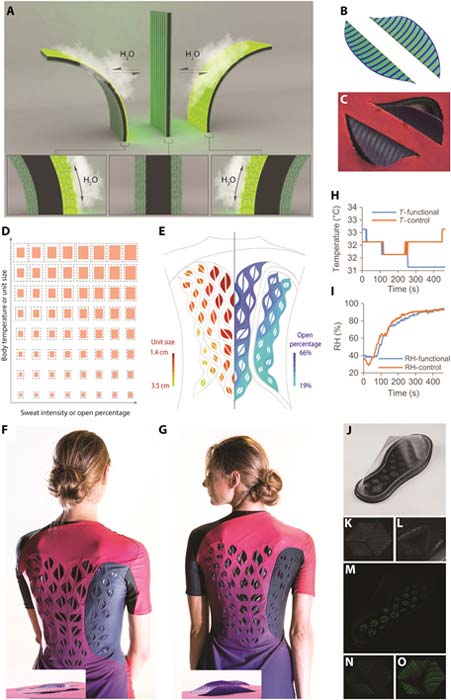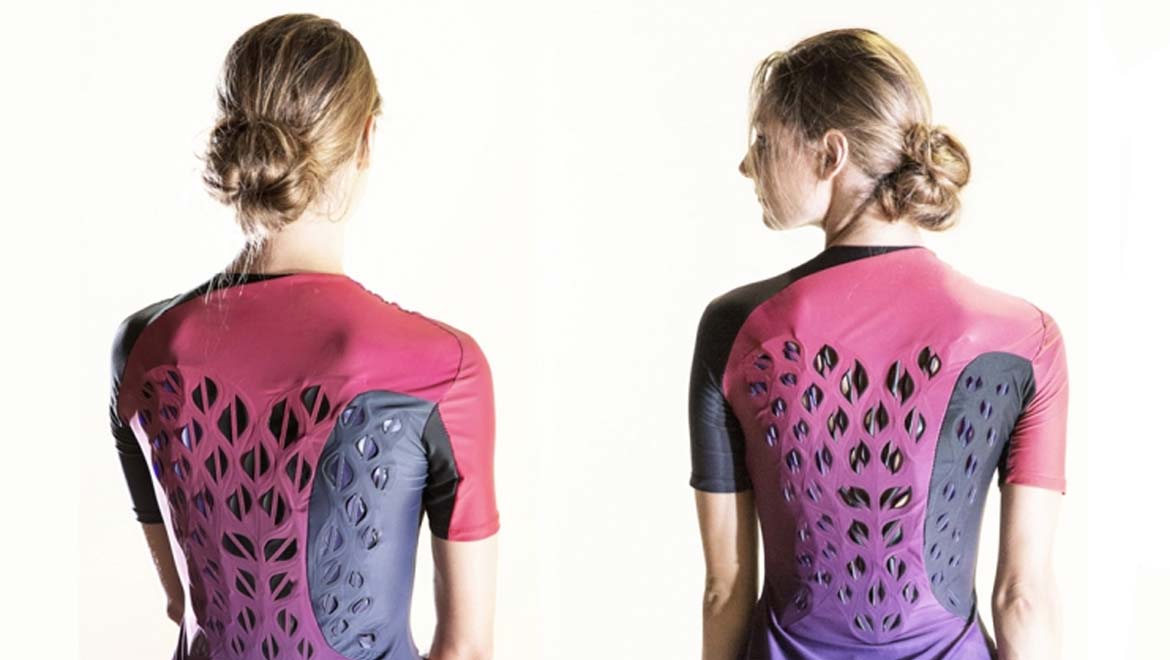Usually when we go for a run and work up a sweat, we would stop and take a layer off. MIT have developed a workout suit which instead responds to your body heat, opening and closing tiny flaps which react to humidity and allow heat and sweat to escape.
How have they achieved this amazing feat? By using live microbial cells, which expand and contract in response to body temperature and sweat levels. When the body is too hot, the cells respond by opening the flaps in order to cool the body down. Once the wearer’s body temperature has dropped, they pull the flaps closed again.
This fabric has been dubbed ‘biohybrid wearables’ and uses cells which are sensitive to moisture levels and respond to this change in humidity. These cells can be easily genetically engineered to also express many other functions including fluorescence. One great benefit of this is that the cells can be engineered to light up in response to sweat, allowing others to see runners on a dark winter’s night.
Heat and sweat maps were used to produce both male and female versions of the running suit, allowing the positioning and the size of the flaps to be determined according to where the majority of sweat and heat are produced.
Biologic from Tangible Media Group on Vimeo.
Once the location of the flaps had been successfully determined, it was time to construct the suits.
For this, a technique called bioprinting was used. Here, the live microbial cells were printed onto a latex substrate. The reaction of the microbial cells to humidity it so strong that when they react to humidity, they also cause the substrate to bend, thus allowing the flaps on the suit to open and close.
During trials to test the suits effectiveness, participants used treadmills and exercise bikes whilst temperature and humidity levels of their bodies was monitored. After five minutes, the suits flaps began to open, which allowed for efficient removal of sweat, combined with a reduction in body temperature. This was compared to a similar suit which had non-functional flaps.
The team has also designed both a trainer, the sole of which also has a number of biohybrid flaps, which open in response to sweat from the user’s feet.
The research was published in Science Advances on 19th May 2017.
The garments were also subjected to 100 dry-wet cycles, intended to demonstrate their long term performance however, the team intend to improve on this with further refinements to their design.

Performance of sandwich-structured biohybrid film for making sweat-responsive wearables. (A) Shape transformation of a flat sandwich-structured biohybrid film when exposed to moisture. (B and C) Stress simulation (B) and experimental bending behavior (C) of a ventilating flap at the open stage when exposed to skin with high humidity. (D) Garment design principle considering both the amount of sweat and body temperature gradient during exercise (note S4). (E) Design of a female garment prototype based on heat maps (left, unit size) and sweat maps (right, percentage of opened area) of the back (note S5). (F and G) Images of garment prototype before exercise with flat ventilation flaps (F) and after exercise with curved ventilation flaps (G). (H and I) Temperature (H) or RH (I) profiles of stagnant air layer near volunteer skin when she wears the female garment with either functional flaps (blue) or nonfunctional flaps (orange). (J to L) The image of the shoe under transmitted light (J) and the flap on the sole at low (K) or high humidity (L). (M to O) The image of the shoe under fluorescence light (M) and the flap on the sole at low (N) or high humidity (O). (advances.sciencemag)
The intention is that this technology won’t only be used in fitness fabrics, although the benefit here is clear. The researchers also anticipate that it could be used in a wide range of other industries, including skin care and biomedical textiles.
Co-author Xuanhe Zhao said “we believe this new field of living materials and devices will find important applications at the interface between engineering and biological systems.”
Top image: This breathable workout suit prototype has ventilating flaps that open and close in response to an athlete’s body heat and sweat. The left photo was taken before exercise when ventilation flaps are flat; after exercise, the ventilation flaps have curved. Image: Hannah Cohen







No comment